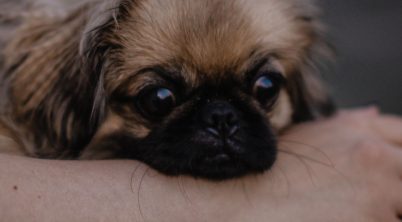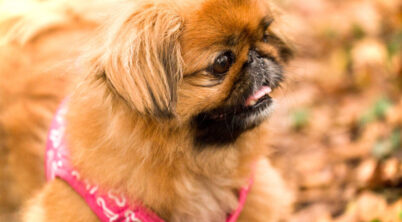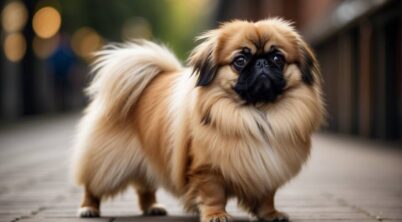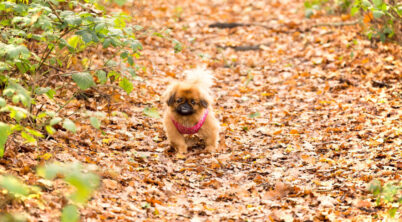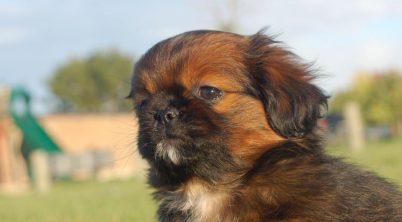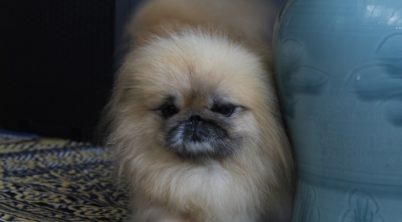Feeding a Pekingese requires understanding their unique dietary needs. This toy breed, known for its lion-like appearance and compact size, has a slower metabolism compared to larger dogs, putting them at a higher risk for obesity. It’s important to closely monitor their diet to maintain their health over their lifespan. An adult Pekingese typically consumes about half to one cup of dry food each day, divided into two meals.
Appropriate nutrition is critical at every stage of a Pekingese’s life. Puppies have different calorie and nutrient requirements than adults and senior dogs, and the type of food provided should reflect their growth needs. High-quality food that includes sufficient protein from animal-based sources is essential. These sources include beef, chicken, turkey, lamb, duck, eggs, and fish, crucial for their development and upkeep.
A structured feeding schedule and adherence to recommended portion sizes can aid in preventing overfeeding. Adapting food amount and type based on the dog’s activity level and health status allows for a tailored approach to each individual Pekingese. Alongside dry food, hydration, with high moisture foods and plenty of clean drinking water, supports their overall well-being.
Table of Contents
Pekingese Nutritional Fundamentals
When feeding a Pekingese, understanding their specific nutritional requirements is crucial to maintain their health and vitality. A balanced diet, rich in high-quality proteins, healthy fats, and the right balance of carbohydrates and fiber, ensures they get the energy they need while preventing obesity.
Understanding Pekinese Nutritional Needs
Pekinese have a slower metabolism compared to larger breeds, making them prone to obesity if overfed. They require a diet that’s appropriately portioned to their small size but rich in nutrients to support their energy levels. A Pekinese’s nutritional needs also include maintaining their distinct coat, which necessitates particular attention to the quality of their diet.
Protein and Fat Requirements
Proteins play a vital role in repairing tissues and supporting the immune system. Pekinese dogs should consume diets with high-quality protein sources like beef, chicken, turkey, and fish. Fats are equally important as they provide essential fatty acids for a healthy coat and skin. Healthy fats also supply concentrated energy for Pekinese, who have relatively low endurance.
- Recommended protein sources:
- Beef
- Chicken
- Turkey
- Lamb
- Duck
- Eggs
- Fish
- Importance of fats:
- Provides essential fatty acids
- Supplies concentrated energy
The Role of Carbohydrates and Fiber
Carbohydrates are necessary for providing a Pekinese with energy, while fiber aids in digestion and helps keep them feeling full. However, carbohydrates should be provided in moderation to avoid unnecessary weight gain. Complex carbohydrates that also contain fiber, such as vegetables and certain grains, are the most beneficial.
- Functions of carbohydrates and fiber in a Pekinese diet:
- Energy source: vital for daily activities
- Digestive health: fiber keeps bowel movements regular
- Weight management: fiber adds bulk without excess calories
Feeding Guidelines by Life Stage
The feeding needs of Pekingese dogs vary significantly with age, commanding a tailored approach throughout each life stage to ensure optimal health and energy levels.
Puppy Feeding Guidelines
Pekingese puppies experience rapid growth and development which requires a diet rich in protein to support their muscle and bone development. Puppies should be fed 4-6 times per day up until the age of six months. After six months, the feeding frequency can be reduced to 3 times per day. It is imperative that the food provided is specifically formulated for small breed puppies to facilitate proper growth. The ideal weaning process should begin at four weeks of age, gradually introducing them to solid food while monitoring their weight and energy levels.
Adult Feeding Regimen
As Pekingese transition into adulthood at about one year of age, their diet and portion sizes must adjust accordingly, as their energy needs decrease compared to their puppy stage. Adult Pekingese typically require 1/2 to 1 cup of dry food per day, divided into two meals. A consistent feeding schedule promotes healthy digestion and weight management. The amount of food, however, may vary based on each individual dog’s activity level and metabolism. It is essential to monitor the dog’s weight vigilantly to prevent obesity, which is a common issue for the breed.
Senior Dietary Considerations
Senior Pekingese, usually dogs older than seven years, will have a further decrease in energy requirements and may need adjustments in their diet to accommodate lower activity levels and slower metabolism. It’s beneficial to introduce foods that are easy to digest and lower in fat, yet full of nutrients to support ageing joints and organs. Smaller, more frequent meals can benefit seniors by easing digestion. Continuing to monitor the dog’s weight remains crucial to reduce the strain on their bodies and promote a healthy lifespan.
Avoiding Common Health Issues
Proper feeding habits in Pekingese can prevent several health issues related to obesity, allergies, and digestive problems.
Preventing Obesity and Weight Gain
To avoid obesity and manage weight gain in Pekingese, it’s crucial to balance their calorie intake with their activity level. This breed is prone to becoming overweight, which can lead to further health conditions such as joint problems and diabetes. Adhere strictly to the recommended feeding amounts, usually 1/2 to 1 cup of dry food per day, divided into two meals, and regulate treats. Regular exercise is also essential to maintain a healthy weight.
Dealing with Allergies and Sensitivities
Pekingese may develop food allergies or sensitivities, presenting symptoms like itchy skin, ear infections, or gastrointestinal upset. Identification of allergens through an elimination diet is a thorough approach to pinpointing the cause. Use hypoallergenic or limited ingredient diets as prescribed. It is important to monitor any adverse reactions closely and consult a veterinarian for recommendations on appropriate foods.
Digestive Health and Bloat Prevention
Pekingese’s digestive system can be sensitive, and they are susceptible to bloat, a quick and serious stomach condition. To support digestive health, feed multiple small meals throughout the day rather than one large meal. Slow-feeding bowls can help reduce the risk of bloat by encouraging slower eating. Additionally, ensuring a diet containing the right balance of fiber aids in regular digestion and can prevent digestive issues. Avoid foods that are known to cause gas or stomach upset in your Pekingese.
Choosing the Right Dog Food
Selecting the appropriate food is crucial for a Pekingese’s health, taking into account factors like protein content, food type, and quality of ingredients.
Comparing Wet and Dry Food
Wet food typically provides higher moisture content beneficial for hydration, whereas dry food may be more convenient and supportive of dental health due to its texture. Dry dog food is often recommended for Pekingese in measured amounts – around 1/2 to 1 cup daily – as it assists in keeping their teeth clean and is easy to store. Conversely, wet food might be preferable for Pekingese with particular dietary needs or for those requiring more water in their diet.
Deciphering Dog Food Labels
When examining dog food labels, it’s essential to look for high-quality protein sources listed at the top, such as beef, chicken, or fish. The label should also break down the content of proteins, fats, carbohydrates, and vitamins and minerals. Owners should ensure the diet includes a balance of these nutrients, with protein being a primary focus for the Pekingese’s needs.
Natural and Commercial Food Options
Owners can choose between natural or commercial dog foods, noting that some natural diets may offer a variety of proteins and natural vitamins and minerals from bone and plant sources. Grain-free options are available and may benefit some dogs, but it is not universally required for all Pekingese. Whichever the choice, the benefits of a well-balanced diet include maintaining an ideal weight and supporting overall health.
Feeding Practices and Portion Control
In managing a Pekingese’s diet, precise portion control and understanding their unique caloric needs are essential to prevent overfeeding and underfeeding. Food choice and feeding schedules play a pivotal role in maintaining the breed’s health.
Calculating Daily Caloric Needs
To determine the ideal caloric intake for a Pekingese, one must consider the dog’s size, age, and activity level. Since Pekingese are a small breed with a slower metabolism, their overall calorie requirements are less than those of larger breeds. An adult Pekingese typically requires between 300 and 400 calories per day, varying with individual metabolism and activity levels.
Understanding Portion Sizes
Portion sizes for Pekingese should align with their caloric requirements to maintain optimal weight. On average, an adult Pekingese needs about ½ to 1 cup of dry food per day. This measurement can fluctuate depending on the calorie content of the chosen food. It’s critical to follow the feeding guidelines on the food package and adjust the portions in response to the dog’s health and activity. Here’s a simplified guideline:
- Inactive dogs: ½ cup of dry food daily
- Moderately active dogs: ¾ cup of dry food daily
- Active dogs: Up to 1 cup of dry food daily
These are general estimates and should be tailored to the specific dog.
Scheduling Meals and Treats
Pekingese thrive on a consistent feeding schedule, typically two meals per day—morning and evening. Consistency aids in digestion and weight management. Treats should be given sparingly to avoid excess calorie intake and should not exceed 10% of the daily caloric needs. When implementing a feeding schedule, consider the dog’s preferences and habits while remaining mindful of portion sizes to prevent overfeeding.
Additional Care for Pekingese Health
Taking care of a Pekingese extends beyond feeding; it involves regular exercise, proper grooming, and attention to joint and dental health for their overall well-being.
Exercise and Physical Activity
A Pekingese requires consistent physical activity to maintain optimal health. They should engage in moderate exercise through two 15- to 20-minute walks per day paired with play sessions. It is important to monitor their breathing, as their flat faces can lead to respiratory issues with too much exertion.
- Exercise Needs:
- Short walks: twice a day
- Playtime: daily
Grooming for Health
Grooming is not just for appearance; it promotes good health. Regular brushing of the Pekingese’s coat removes dirt and reduces shedding, while keeping the skin clean and healthy. Bathing should be done as needed but not so frequently that it dries out their skin.
- Grooming Routine:
- Brushing: Several times a week
- Bathing: Monthly or as required
Addressing Joint and Dental Health
Joint health is a priority for the toy breed, given their stature and susceptibility to issues. Supporting surfaces for sleep and careful handling can prevent unnecessary strain. Dental health is maintained through regular brushing to prevent plaque buildup, which can lead to serious health concerns. Feeding them specially formulated small-breed food also contributes to dental cleanliness.
- Joint Health:
- Comfortable bedding
- Minimal jumping or rough play
- Dental Health:
- Brushing: 2-3 times a week
- Diet: Small-breed specific kibble

